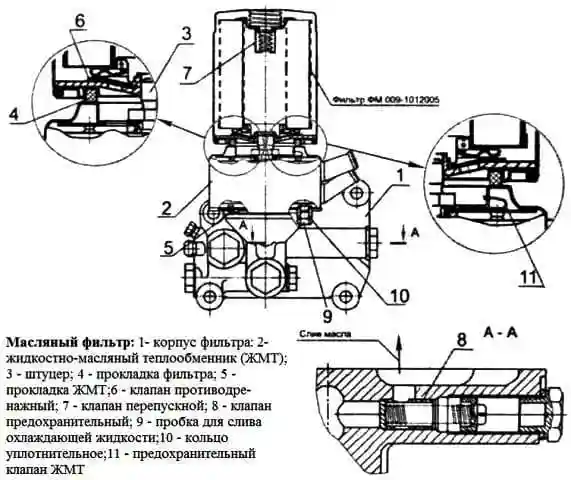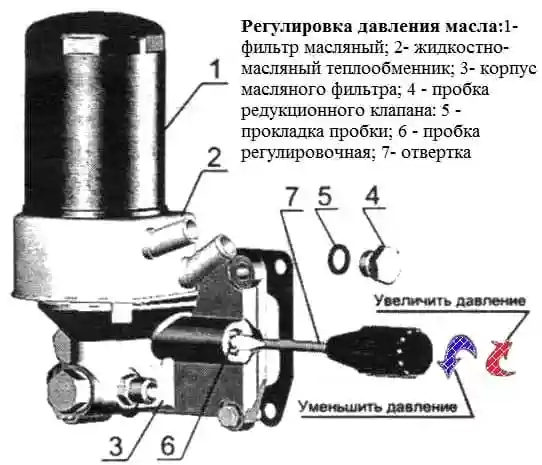Combined diesel lubrication system
Oil pump - gear type, single section
The oil pump is driven by a gear mounted on the crankshaft.

Scheme of the lubrication system: 1 - oil crankcase; 2 - piston cooling nozzles; 3 - crankshaft; 4 - camshaft; 5 - intermediate gear; 6 - oil filler neck; 7 - oil crankcase plug; 8 - oil receiver 9 - oil pump; 10 - liquid-oil heat exchanger (LMO); 11 - bypass valve; 12 - oil filter; 13 - bypass valve; 14 - safety valve; 15 - pressure sensor; 16 - turbocharger; 17 - compressor; 18 - high pressure fuel pump; 19 - oil channel of the rocker axle
The oil pump 9 takes oil from the oil crankcase 1 through the oil receiver 8 and delivers it through the channels in the cylinder block and the channels of the oil filter housing to the liquid-oil heat exchanger 10, and then to the full-flow oil filter 12 and to the diesel oil line.
From the main line of the diesel engine, oil flows through the channels in the cylinder block to all main bearings of the crankshaft and camshaft journals.
From the main bearings, oil flows through channels in the crankshaft to all connecting rod bearings.
From the first main bearing, oil flows through special channels to the intermediate gear and fuel pump drive gear bushings, as well as to the fuel pump.
The parts of the valve mechanism are lubricated with oil coming from the rear camshaft bearing through the channels in the block, cylinder head, drilling in the IV rack of the rocker arms into the inner cavity of the rocker arm axis and through the hole in the rocker arm bushing, from which it goes through the channel to the adjusting screw and rod .
Oil is supplied to the compressor from the main line through drillings in the cylinder block and a special oil pipeline.
Oil is drained from the compressor into the diesel crankcase.
Oil enters the turbocharger bearing assembly through a pipe connected at the outlet of the oil filter housing.
From the bearing assembly of the turbocharger, oil is discharged through the tube into the oil sump
Bypass (reducing) valves are installed in the body of the liquid-oil heat exchanger - 11 (setting pressure value - 0.15 ... 0.20 MPa) and in the oil filter - 13 (setting pressure value 0.13 ... 0 .17 MPa).
When starting a diesel engine with cold oil, when the resistance to oil flow in the liquid-oil heat exchanger exceeds 0.15-0.2 MPa, the bypass valve opens and the oil, bypassing the liquid-oil heat exchanger, enters the oil filter, and when resistance in the oil filter is 0.13 ... 0.17 MPa, the oil filter bypass valve opens and the oil, bypassing the oil filter, enters the oil line.
Blow-off valves are non-adjustable.
A safety adjustable valve 14 is built into the filter housing, designed to maintain the oil pressure in the main oil line at 0.25 ... 0.35 MPa.
Excess oil is drained through the valve into the diesel crankcase.
In case of excessive clogging, when the resistance of the oil filter becomes higher than 0.13-0.17 MPa, the filter bypass valve also opens, and oil, bypassing the oil filter, enters the oil line.
Attention! On a running diesel engine, it is strictly forbidden to unscrew the plug of the pressure reducing valve!
Maintenance of the lubrication system consists in daily monitoring of the oil level in the crankcase, oil pressure control, timely replacement of oil and filter.
The oil level should be checked daily before starting the engine and not earlier than 3 minutes after stopping the engine.
The bus must be installed on a flat horizontal platform.
The oil level should be between the lower and upper marks on the dipstick.
It is forbidden to operate the engine with the oil level below the lower and above the upper mark of the oil gauge.
The oil pressure of the engine lubrication system is controlled by the indicator located on the instrument panel.
When the diesel engine is running at a nominal speed and coolant temperature (85-95) ° C, the oil pressure should be at the level of (0.25-0.35) MPa, the pressure on a cold engine is allowed up to 0.8 MPa .
At the minimum idle speed, the oil pressure in the lubrication system of a warm engine must be at least 0.08 MPa.
Oil is changed every 8000 km. An oil change is allowed after 10,000 km.
Attention! In the case of the use of backup oils or fuels with a high sulfur content, the oil must be changed after (4000…5000) kilometers.
Backup oils include: M-10 G2K and M-8 G2K.
Oil change in the diesel crankcase is carried out on a preheated engine.
To drain the oil, unscrew the oil crankcase plug.
After all the oil has drained from the crankcase, screw the plug back in place.
Pour oil into the diesel engine through the oil filler pipe to the level of the upper mark on the oil gauge.
Pour into the oil sump only the oil recommended by this manual, corresponding to the period of operation.
The use of oils of other brands can lead to malfunctions of the diesel engine.
Oil filter replacement is carried out simultaneously with the change of oil in the engine crankcase and the results of diagnostics of the "COMMON RAIL" system in the following sequence:

Oil filter: 1 - filter housing; 2 - liquid-oil heat exchanger (LHT); 3 - fitting; 4 - filter gasket; 5 - gasket LMT; 6 - anti-drainage valve; 7 - bypass valve; 8 - safety valve; 9 - plug for draining the coolant; 10 - sealing ring; 11 - safety valve ZhMT
Clean the interface between the oil filter and valve body 1 from dirt.
Unscrew the filter FM 009-1012005 or M5101 from fitting 3 using a special wrench or other available means.
Wipe the mating surface in the valve body.
Fill the new filter with clean oil and install (screw onto the fitting) the FM 009-101201 or M5101 filter assembly with gasket 4, which must first be lubricated with engine oil.
After the gasket touches the filter housing, tighten the filter another 1-1.5 turns.
Install the filter only by hand
Instead of the filter FM 009-1012005 and M5101, it is allowed to install filter cartridges of a non-separable type: mod. X149 by AC Lelko (France), mod. L37198 from Purolator (Italy) and other companies that have anti-drainage and bypass valves in their design with the main overall dimensions:
- - diameter - 95-105 mm;
- - height - 140-160 mm;
- - thread - 3/4-16UNF.
Adjustment of the safety (drain) valve is carried out when the oil pressure in the engine lubrication system drops below 2.5 kgf/cm².
Adjustment should be carried out with the engine turned off and warm

Adjusting oil pressure: 1 - oil filter; 2 - liquid-oil heat exchanger; 3 - oil filter housing; 4 - plug of the reducing valve: 5 - plug gasket; 6 - adjusting plug; 7 - screwdriver
Unscrew plug 4 (Fig. 3), remove gasket 5.
In the channel of the oil filter housing 3, use a screwdriver 7 to turn the adjusting plug 6 one turn in the direction of increasing or decreasing the pressure value (depending on the actual pressure).
Install gasket 5 and screw on plug 4.
If necessary, repeat the indicated adjustment steps.





